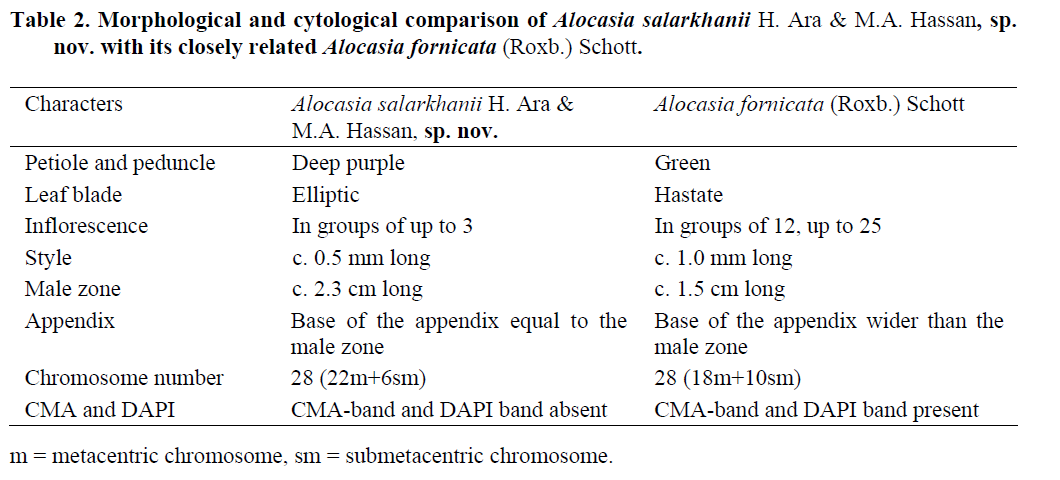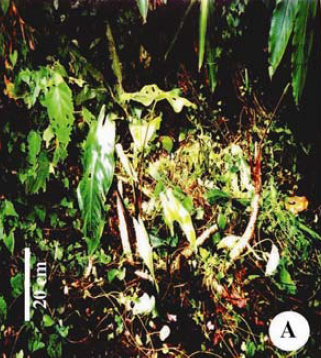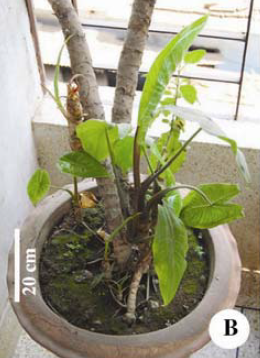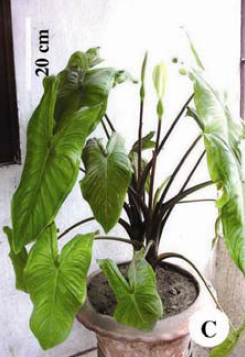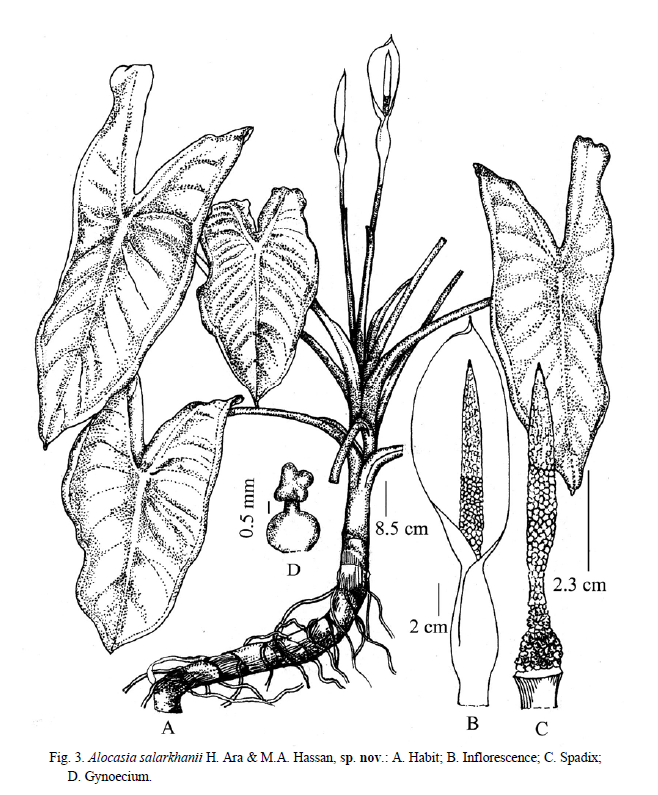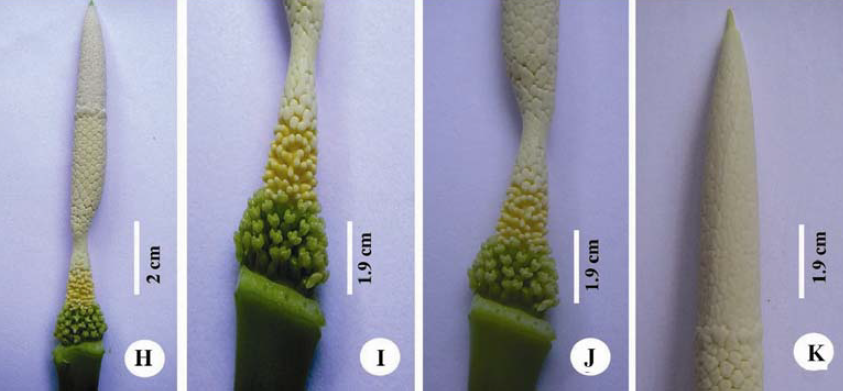ALOCASIA SALARKHANII
ORIGINAL DESCRIPTION:
Alocasia salarkhanii H. Ara & M.A. Hassan is closely related to Alocasia fornicata (Roxb.) Schott but can be easily differentiated by the color of petiole and a deep purple peduncle; shape of lamina long elliptic; number of inflorescences groups less than 4; length of style c. 0.5 mm long; male zone c. 2.3 cm long; and width of the appendix base and male zone are equal.
Three new species of Araceae from Bangladesh | Bangladesh Journal of Plant Taxonomy 25(2):227-239
SYNONYMS: N/A
DISTRIBUTION: Bangladesh, Moulvibazar district, Lawachara reserve forest, 15.05.20005, Hosne Ara HA 1467 (DACB).
CLIMATE: Tropical humid climate
Humidity is moderate throughout the year, ranging from 60% to 70%
Temperature is varies between the seasons - within the range of 48°F/9°C to 88°F/31°C during the day. Minimum temperatures never dip below 45°F/7°C
Rainy and humid season (October to May) and a dry season between June and October. The average annual rainfall is 1,200 mm
ECOLOGY: Grows on the hilly area as undergrowth.
SPECIES DESCRIPTION:
Small to moderately robust herb. Stem erect to decumbent, up to 4 cm in diameter, c. 60 cm long, clothed in the brown remains of old leaf bases. Leaves several together, held almost erect or slightly curved; petiole 35-52 cm long, sheathing c. 1/3 from the base of petiole, eglandular, deep purple, wings of the sheath out-rolled; blade hastato-sagittate, rather narrowly triangular, margin entire to slightly undulate, glossy, leathery, dark green, glabrous adaxially, pale green and pubescent abaxially, 31-51 cm long, 14.0-21.5 cm in diameter at the base; anterior lobes 18-33 cm long with apiculate tip 0.6-1.0 cm long; anterior costa prominent on both surfaces, glabrous on both surfaces, primary veins 6 on each side, prominent on both surfaces, diverging at 450-900, secondary venation flush on both surfaces, mostly arising from the primary veins at a wide angle, then deflected towards the margin, forming variously well-defined interprimary collective veins or these absent, interprimary collective veins when present weakly undulating to strongly zig-zag at base broad acute angles; submarginal vein 0.8-1.0 cm from the margin; glands in the axils of primary veins absent or extremely inconspicuous; posterior lobes 13-18 cm long, acute, peltate, 2.3-3.0 cm long; posterior costae straight to incurved.
INFLORESCENCE:
Inflorescences 3 in the center of the leaf crown, bloom one after another, subtended by a cataphyll, cataphyll up to 25 cm long, purple; peduncle deep purple, smooth, 26-31 cm long, 0.7-1.3 cm in diameter at the base. Spathe c. 15 cm long; lower spathe convolute, c. 4.2 cm long, green; limb c. 11.7 cm long, c. 4.8 cm in diameter, light yellowish with violet or pink mixed on both sides. Spadix shorter than spathe, c. 11.5 cm long. Lower fertile female zone c. 1 cm long; sterile female zone c. 0.5 cm long, c. 1.3 cm in diameter at the base; pistil closely packed; ovary sub-globose, green, c. 2 x 2 mm, unilocular, with basal placenta; style distirct, stout, c. 0.5 mm long, c 0.8 mm in diameter, light yellow; stigma 3-4 lobed, lobes acute, light yellow; sterile interstice c. 2 cm long, narrower than the fertile zones, corresponding with the spathe constriction; lower synandrodia often with incompletely connate staminodes, the rest elongate rhombo-hexagonal, flat-topped; male zone cyclindric, somewhat tapered at the base, c. 2.3 cm long, c. 0.8 cm thick, ivory in colour; synandria more or less hexagonal, c. 2 mm in diameter, androus; appendix c. 3.5 cm long, c. 0.8 cm thick at the middle, about the same thickness at the male zone, gradually tapering to a pointed tip, cream coloured. Fruit orange-red; fruiting peduncle 33-35 cm long, fruiting spathe ovoid, 4-6 cm long.
Flowering and fruiting period: May - August.
Chromosome number: 2n = 28 (Afroz et al., 2013).
VARIEGATED FORMS: N/A
ETYMOLOGY: The species is named in honour of Dr. Md. Salar Khan, known as the father of plant taxonomy in Bangladesh.
NOTES:
The major morphological and cytological differences between the new species Alocasia salarkhanii and its closely allied species Alocasia fornicata are outlined below:
Conservation status: Critically Endangered (IUCN, 2017). Located in a very restricted area,should be conserved both by in situ and ex situ methods.
Specimens examined: Moulvibazar: Lawachara reserve forest, 15.05.2005, Hosne Ara HA 1467 (DACB); 04.07.2005, Hosne Ara HA 1781 (DACB); Dhaka: Khilgaon, Tilpapara (Cultivated), 07.05.2006, Hosne Ara HA 2630 (DACB); Bangladesh National Herbarium garden (Cultivated), 30.05.2006, Hosne Ara HA 2651 (DACB) [Originally collected from Lawachara reserve forest under Moulvibazar districts]
CULTIVARS: N/A
HYBRIDS: N/A




